Relationship between Foreign Direct Investment and GDP growth of Vietnam
VerifiedAdded on 2023/01/12
|13
|3478
|24
AI Summary
This thesis investigates the relationship between Foreign Direct Investment (FDI) and GDP growth in Vietnam. It analyzes the concept of FDI and GDP, evaluates various models and theories for their relationship, and uses econometrics to assess the impact of FDI on Vietnam's economic growth. The study aims to understand the influence of FDI on GDP and its implications for Vietnam's development.
Contribute Materials
Your contribution can guide someone’s learning journey. Share your
documents today.
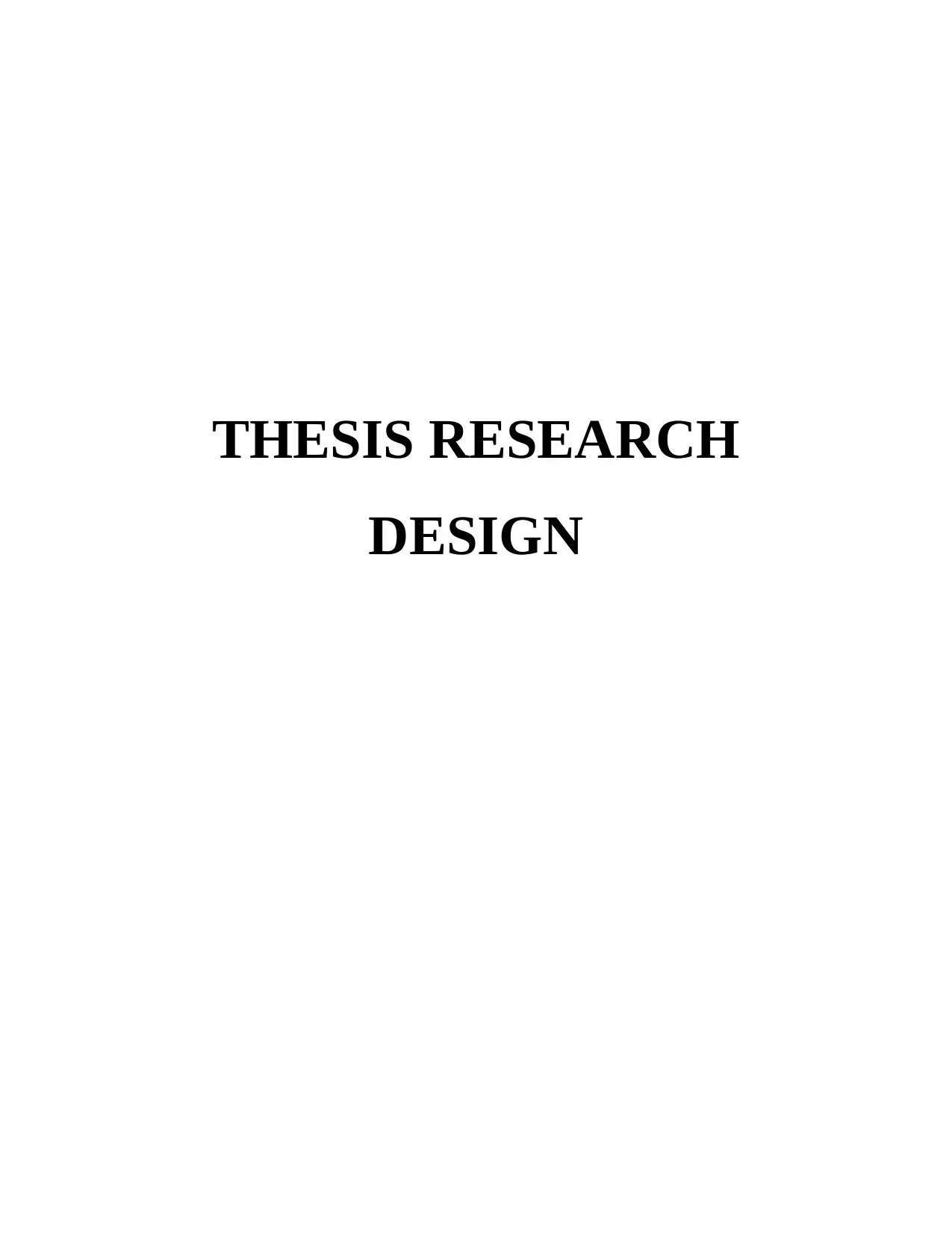
THESIS RESEARCH
DESIGN
DESIGN
Secure Best Marks with AI Grader
Need help grading? Try our AI Grader for instant feedback on your assignments.
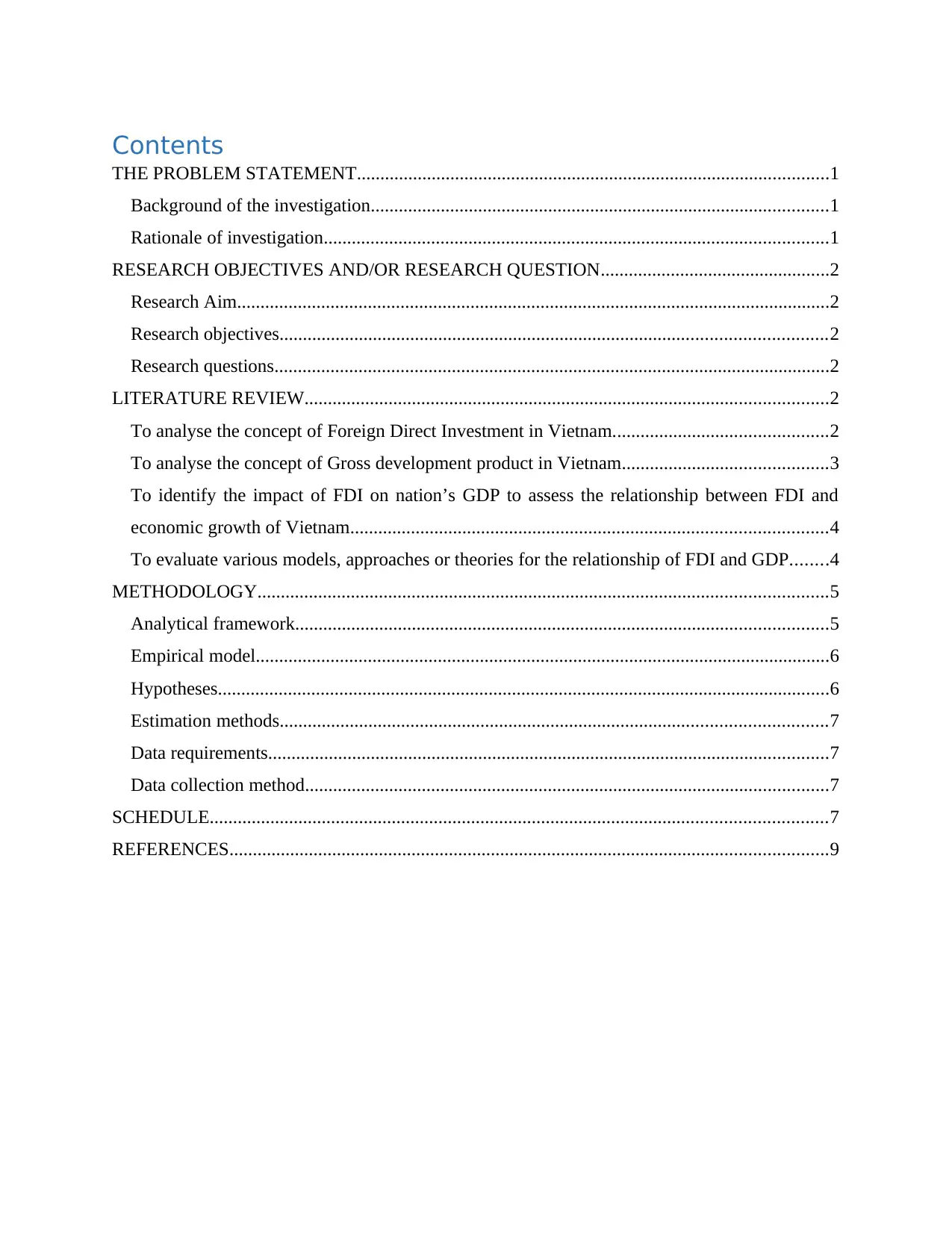
Contents
THE PROBLEM STATEMENT.....................................................................................................1
Background of the investigation..................................................................................................1
Rationale of investigation............................................................................................................1
RESEARCH OBJECTIVES AND/OR RESEARCH QUESTION.................................................2
Research Aim...............................................................................................................................2
Research objectives.....................................................................................................................2
Research questions.......................................................................................................................2
LITERATURE REVIEW................................................................................................................2
To analyse the concept of Foreign Direct Investment in Vietnam..............................................2
To analyse the concept of Gross development product in Vietnam............................................3
To identify the impact of FDI on nation’s GDP to assess the relationship between FDI and
economic growth of Vietnam......................................................................................................4
To evaluate various models, approaches or theories for the relationship of FDI and GDP........4
METHODOLOGY..........................................................................................................................5
Analytical framework..................................................................................................................5
Empirical model...........................................................................................................................6
Hypotheses...................................................................................................................................6
Estimation methods.....................................................................................................................7
Data requirements........................................................................................................................7
Data collection method................................................................................................................7
SCHEDULE....................................................................................................................................7
REFERENCES................................................................................................................................9
THE PROBLEM STATEMENT.....................................................................................................1
Background of the investigation..................................................................................................1
Rationale of investigation............................................................................................................1
RESEARCH OBJECTIVES AND/OR RESEARCH QUESTION.................................................2
Research Aim...............................................................................................................................2
Research objectives.....................................................................................................................2
Research questions.......................................................................................................................2
LITERATURE REVIEW................................................................................................................2
To analyse the concept of Foreign Direct Investment in Vietnam..............................................2
To analyse the concept of Gross development product in Vietnam............................................3
To identify the impact of FDI on nation’s GDP to assess the relationship between FDI and
economic growth of Vietnam......................................................................................................4
To evaluate various models, approaches or theories for the relationship of FDI and GDP........4
METHODOLOGY..........................................................................................................................5
Analytical framework..................................................................................................................5
Empirical model...........................................................................................................................6
Hypotheses...................................................................................................................................6
Estimation methods.....................................................................................................................7
Data requirements........................................................................................................................7
Data collection method................................................................................................................7
SCHEDULE....................................................................................................................................7
REFERENCES................................................................................................................................9

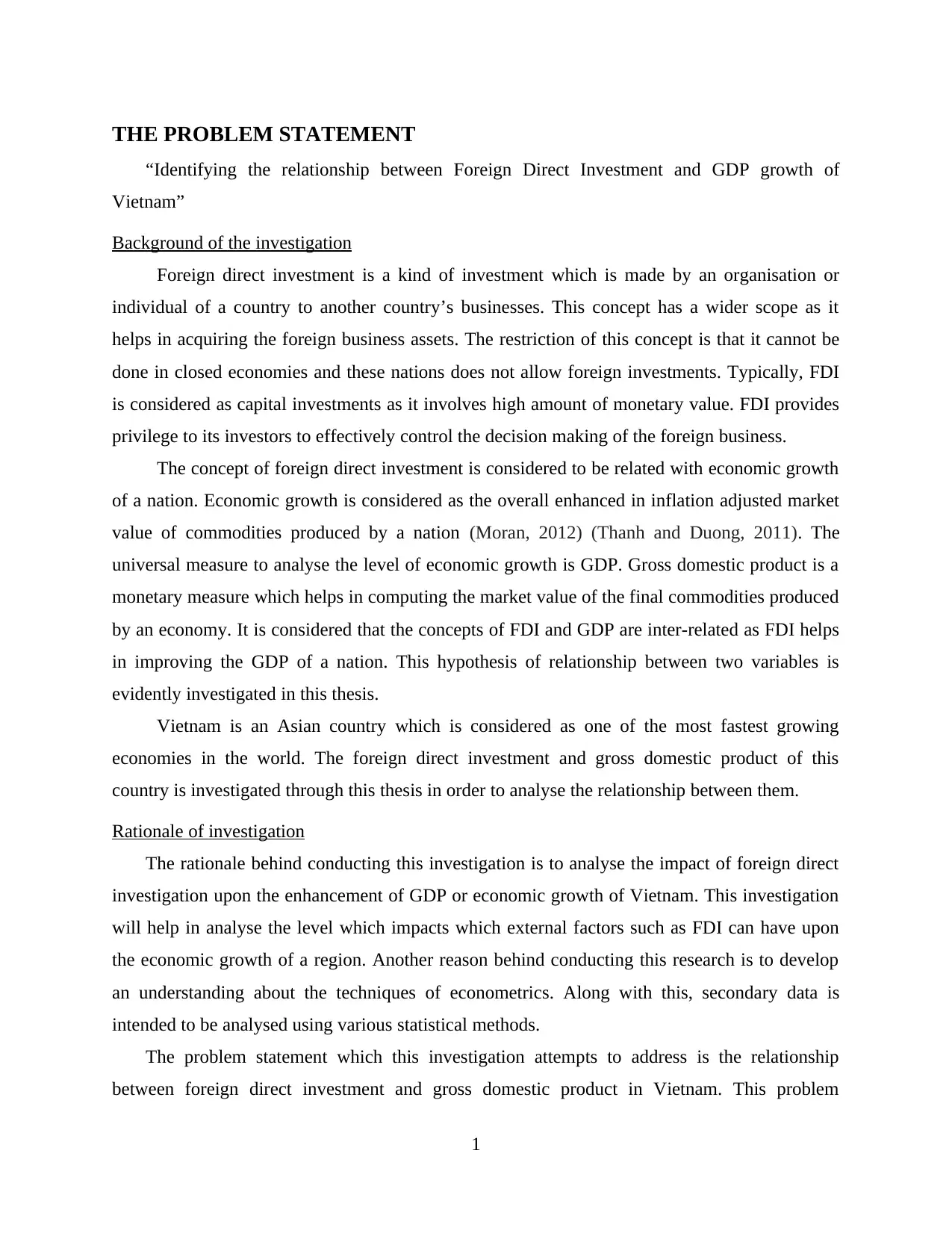
THE PROBLEM STATEMENT
“Identifying the relationship between Foreign Direct Investment and GDP growth of
Vietnam”
Background of the investigation
Foreign direct investment is a kind of investment which is made by an organisation or
individual of a country to another country’s businesses. This concept has a wider scope as it
helps in acquiring the foreign business assets. The restriction of this concept is that it cannot be
done in closed economies and these nations does not allow foreign investments. Typically, FDI
is considered as capital investments as it involves high amount of monetary value. FDI provides
privilege to its investors to effectively control the decision making of the foreign business.
The concept of foreign direct investment is considered to be related with economic growth
of a nation. Economic growth is considered as the overall enhanced in inflation adjusted market
value of commodities produced by a nation (Moran, 2012) (Thanh and Duong, 2011). The
universal measure to analyse the level of economic growth is GDP. Gross domestic product is a
monetary measure which helps in computing the market value of the final commodities produced
by an economy. It is considered that the concepts of FDI and GDP are inter-related as FDI helps
in improving the GDP of a nation. This hypothesis of relationship between two variables is
evidently investigated in this thesis.
Vietnam is an Asian country which is considered as one of the most fastest growing
economies in the world. The foreign direct investment and gross domestic product of this
country is investigated through this thesis in order to analyse the relationship between them.
Rationale of investigation
The rationale behind conducting this investigation is to analyse the impact of foreign direct
investigation upon the enhancement of GDP or economic growth of Vietnam. This investigation
will help in analyse the level which impacts which external factors such as FDI can have upon
the economic growth of a region. Another reason behind conducting this research is to develop
an understanding about the techniques of econometrics. Along with this, secondary data is
intended to be analysed using various statistical methods.
The problem statement which this investigation attempts to address is the relationship
between foreign direct investment and gross domestic product in Vietnam. This problem
1
“Identifying the relationship between Foreign Direct Investment and GDP growth of
Vietnam”
Background of the investigation
Foreign direct investment is a kind of investment which is made by an organisation or
individual of a country to another country’s businesses. This concept has a wider scope as it
helps in acquiring the foreign business assets. The restriction of this concept is that it cannot be
done in closed economies and these nations does not allow foreign investments. Typically, FDI
is considered as capital investments as it involves high amount of monetary value. FDI provides
privilege to its investors to effectively control the decision making of the foreign business.
The concept of foreign direct investment is considered to be related with economic growth
of a nation. Economic growth is considered as the overall enhanced in inflation adjusted market
value of commodities produced by a nation (Moran, 2012) (Thanh and Duong, 2011). The
universal measure to analyse the level of economic growth is GDP. Gross domestic product is a
monetary measure which helps in computing the market value of the final commodities produced
by an economy. It is considered that the concepts of FDI and GDP are inter-related as FDI helps
in improving the GDP of a nation. This hypothesis of relationship between two variables is
evidently investigated in this thesis.
Vietnam is an Asian country which is considered as one of the most fastest growing
economies in the world. The foreign direct investment and gross domestic product of this
country is investigated through this thesis in order to analyse the relationship between them.
Rationale of investigation
The rationale behind conducting this investigation is to analyse the impact of foreign direct
investigation upon the enhancement of GDP or economic growth of Vietnam. This investigation
will help in analyse the level which impacts which external factors such as FDI can have upon
the economic growth of a region. Another reason behind conducting this research is to develop
an understanding about the techniques of econometrics. Along with this, secondary data is
intended to be analysed using various statistical methods.
The problem statement which this investigation attempts to address is the relationship
between foreign direct investment and gross domestic product in Vietnam. This problem
1
Secure Best Marks with AI Grader
Need help grading? Try our AI Grader for instant feedback on your assignments.
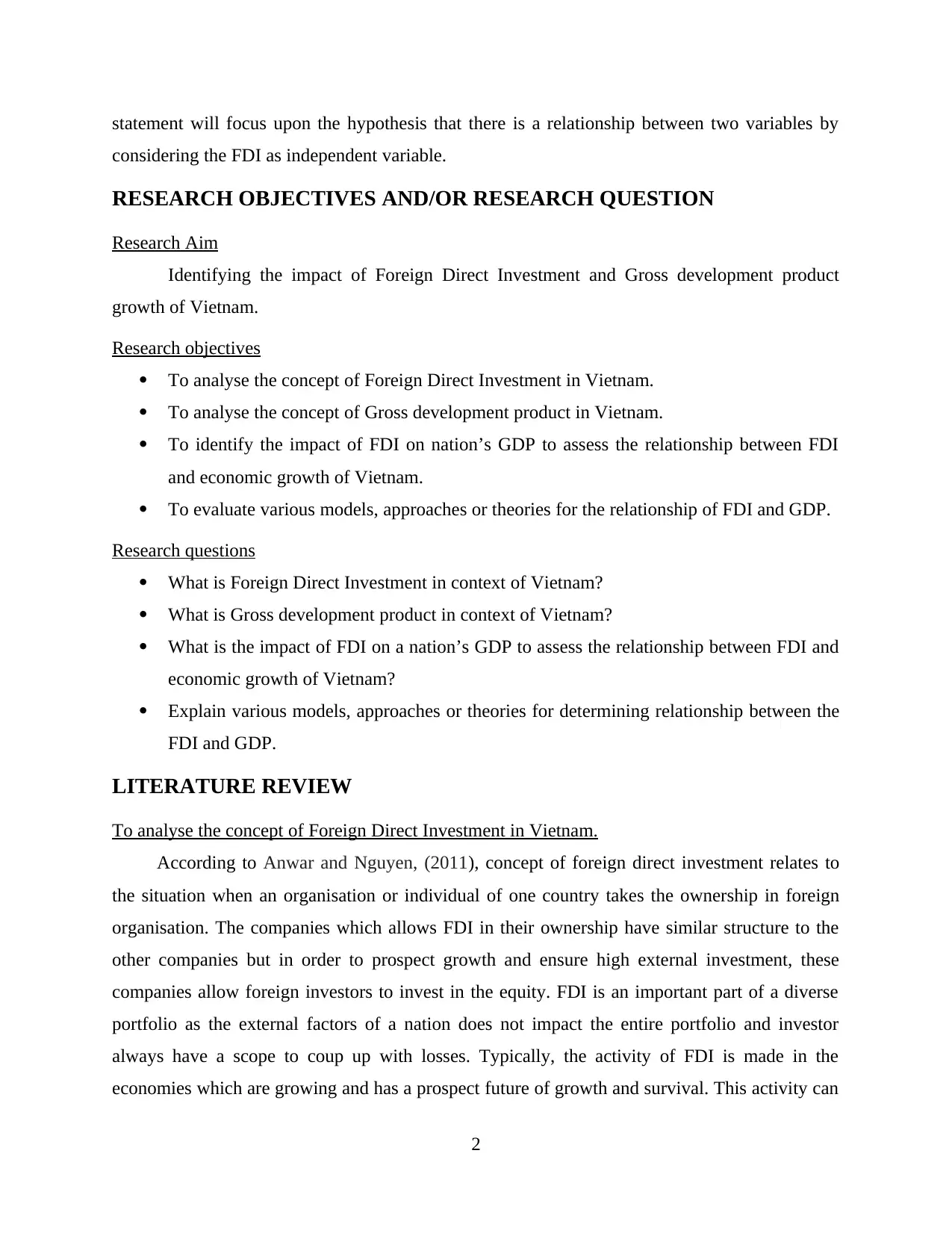
statement will focus upon the hypothesis that there is a relationship between two variables by
considering the FDI as independent variable.
RESEARCH OBJECTIVES AND/OR RESEARCH QUESTION
Research Aim
Identifying the impact of Foreign Direct Investment and Gross development product
growth of Vietnam.
Research objectives
To analyse the concept of Foreign Direct Investment in Vietnam.
To analyse the concept of Gross development product in Vietnam.
To identify the impact of FDI on nation’s GDP to assess the relationship between FDI
and economic growth of Vietnam.
To evaluate various models, approaches or theories for the relationship of FDI and GDP.
Research questions
What is Foreign Direct Investment in context of Vietnam?
What is Gross development product in context of Vietnam?
What is the impact of FDI on a nation’s GDP to assess the relationship between FDI and
economic growth of Vietnam?
Explain various models, approaches or theories for determining relationship between the
FDI and GDP.
LITERATURE REVIEW
To analyse the concept of Foreign Direct Investment in Vietnam.
According to Anwar and Nguyen, (2011), concept of foreign direct investment relates to
the situation when an organisation or individual of one country takes the ownership in foreign
organisation. The companies which allows FDI in their ownership have similar structure to the
other companies but in order to prospect growth and ensure high external investment, these
companies allow foreign investors to invest in the equity. FDI is an important part of a diverse
portfolio as the external factors of a nation does not impact the entire portfolio and investor
always have a scope to coup up with losses. Typically, the activity of FDI is made in the
economies which are growing and has a prospect future of growth and survival. This activity can
2
considering the FDI as independent variable.
RESEARCH OBJECTIVES AND/OR RESEARCH QUESTION
Research Aim
Identifying the impact of Foreign Direct Investment and Gross development product
growth of Vietnam.
Research objectives
To analyse the concept of Foreign Direct Investment in Vietnam.
To analyse the concept of Gross development product in Vietnam.
To identify the impact of FDI on nation’s GDP to assess the relationship between FDI
and economic growth of Vietnam.
To evaluate various models, approaches or theories for the relationship of FDI and GDP.
Research questions
What is Foreign Direct Investment in context of Vietnam?
What is Gross development product in context of Vietnam?
What is the impact of FDI on a nation’s GDP to assess the relationship between FDI and
economic growth of Vietnam?
Explain various models, approaches or theories for determining relationship between the
FDI and GDP.
LITERATURE REVIEW
To analyse the concept of Foreign Direct Investment in Vietnam.
According to Anwar and Nguyen, (2011), concept of foreign direct investment relates to
the situation when an organisation or individual of one country takes the ownership in foreign
organisation. The companies which allows FDI in their ownership have similar structure to the
other companies but in order to prospect growth and ensure high external investment, these
companies allow foreign investors to invest in the equity. FDI is an important part of a diverse
portfolio as the external factors of a nation does not impact the entire portfolio and investor
always have a scope to coup up with losses. Typically, the activity of FDI is made in the
economies which are growing and has a prospect future of growth and survival. This activity can
2
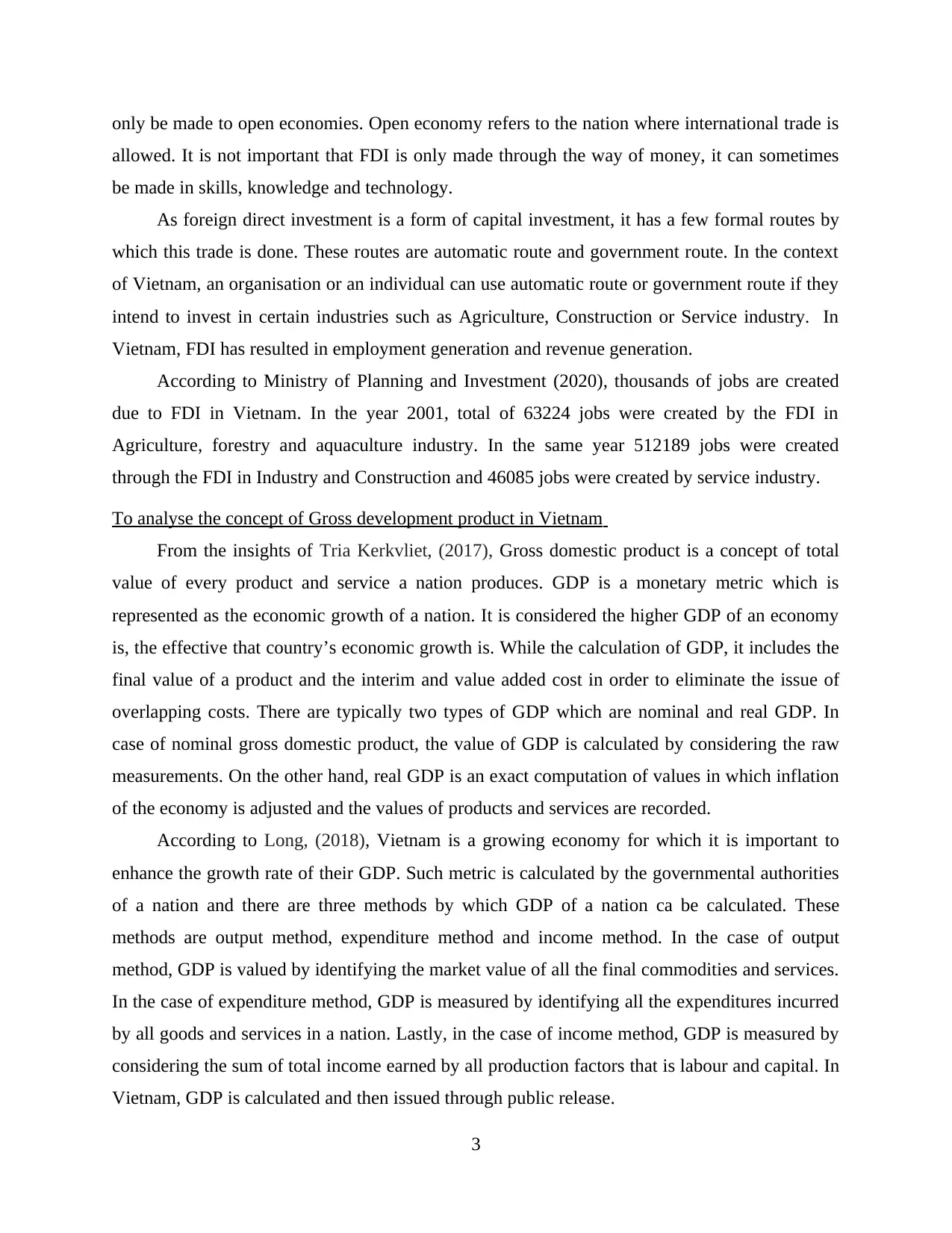
only be made to open economies. Open economy refers to the nation where international trade is
allowed. It is not important that FDI is only made through the way of money, it can sometimes
be made in skills, knowledge and technology.
As foreign direct investment is a form of capital investment, it has a few formal routes by
which this trade is done. These routes are automatic route and government route. In the context
of Vietnam, an organisation or an individual can use automatic route or government route if they
intend to invest in certain industries such as Agriculture, Construction or Service industry. In
Vietnam, FDI has resulted in employment generation and revenue generation.
According to Ministry of Planning and Investment (2020), thousands of jobs are created
due to FDI in Vietnam. In the year 2001, total of 63224 jobs were created by the FDI in
Agriculture, forestry and aquaculture industry. In the same year 512189 jobs were created
through the FDI in Industry and Construction and 46085 jobs were created by service industry.
To analyse the concept of Gross development product in Vietnam
From the insights of Tria Kerkvliet, (2017), Gross domestic product is a concept of total
value of every product and service a nation produces. GDP is a monetary metric which is
represented as the economic growth of a nation. It is considered the higher GDP of an economy
is, the effective that country’s economic growth is. While the calculation of GDP, it includes the
final value of a product and the interim and value added cost in order to eliminate the issue of
overlapping costs. There are typically two types of GDP which are nominal and real GDP. In
case of nominal gross domestic product, the value of GDP is calculated by considering the raw
measurements. On the other hand, real GDP is an exact computation of values in which inflation
of the economy is adjusted and the values of products and services are recorded.
According to Long, (2018), Vietnam is a growing economy for which it is important to
enhance the growth rate of their GDP. Such metric is calculated by the governmental authorities
of a nation and there are three methods by which GDP of a nation ca be calculated. These
methods are output method, expenditure method and income method. In the case of output
method, GDP is valued by identifying the market value of all the final commodities and services.
In the case of expenditure method, GDP is measured by identifying all the expenditures incurred
by all goods and services in a nation. Lastly, in the case of income method, GDP is measured by
considering the sum of total income earned by all production factors that is labour and capital. In
Vietnam, GDP is calculated and then issued through public release.
3
allowed. It is not important that FDI is only made through the way of money, it can sometimes
be made in skills, knowledge and technology.
As foreign direct investment is a form of capital investment, it has a few formal routes by
which this trade is done. These routes are automatic route and government route. In the context
of Vietnam, an organisation or an individual can use automatic route or government route if they
intend to invest in certain industries such as Agriculture, Construction or Service industry. In
Vietnam, FDI has resulted in employment generation and revenue generation.
According to Ministry of Planning and Investment (2020), thousands of jobs are created
due to FDI in Vietnam. In the year 2001, total of 63224 jobs were created by the FDI in
Agriculture, forestry and aquaculture industry. In the same year 512189 jobs were created
through the FDI in Industry and Construction and 46085 jobs were created by service industry.
To analyse the concept of Gross development product in Vietnam
From the insights of Tria Kerkvliet, (2017), Gross domestic product is a concept of total
value of every product and service a nation produces. GDP is a monetary metric which is
represented as the economic growth of a nation. It is considered the higher GDP of an economy
is, the effective that country’s economic growth is. While the calculation of GDP, it includes the
final value of a product and the interim and value added cost in order to eliminate the issue of
overlapping costs. There are typically two types of GDP which are nominal and real GDP. In
case of nominal gross domestic product, the value of GDP is calculated by considering the raw
measurements. On the other hand, real GDP is an exact computation of values in which inflation
of the economy is adjusted and the values of products and services are recorded.
According to Long, (2018), Vietnam is a growing economy for which it is important to
enhance the growth rate of their GDP. Such metric is calculated by the governmental authorities
of a nation and there are three methods by which GDP of a nation ca be calculated. These
methods are output method, expenditure method and income method. In the case of output
method, GDP is valued by identifying the market value of all the final commodities and services.
In the case of expenditure method, GDP is measured by identifying all the expenditures incurred
by all goods and services in a nation. Lastly, in the case of income method, GDP is measured by
considering the sum of total income earned by all production factors that is labour and capital. In
Vietnam, GDP is calculated and then issued through public release.
3
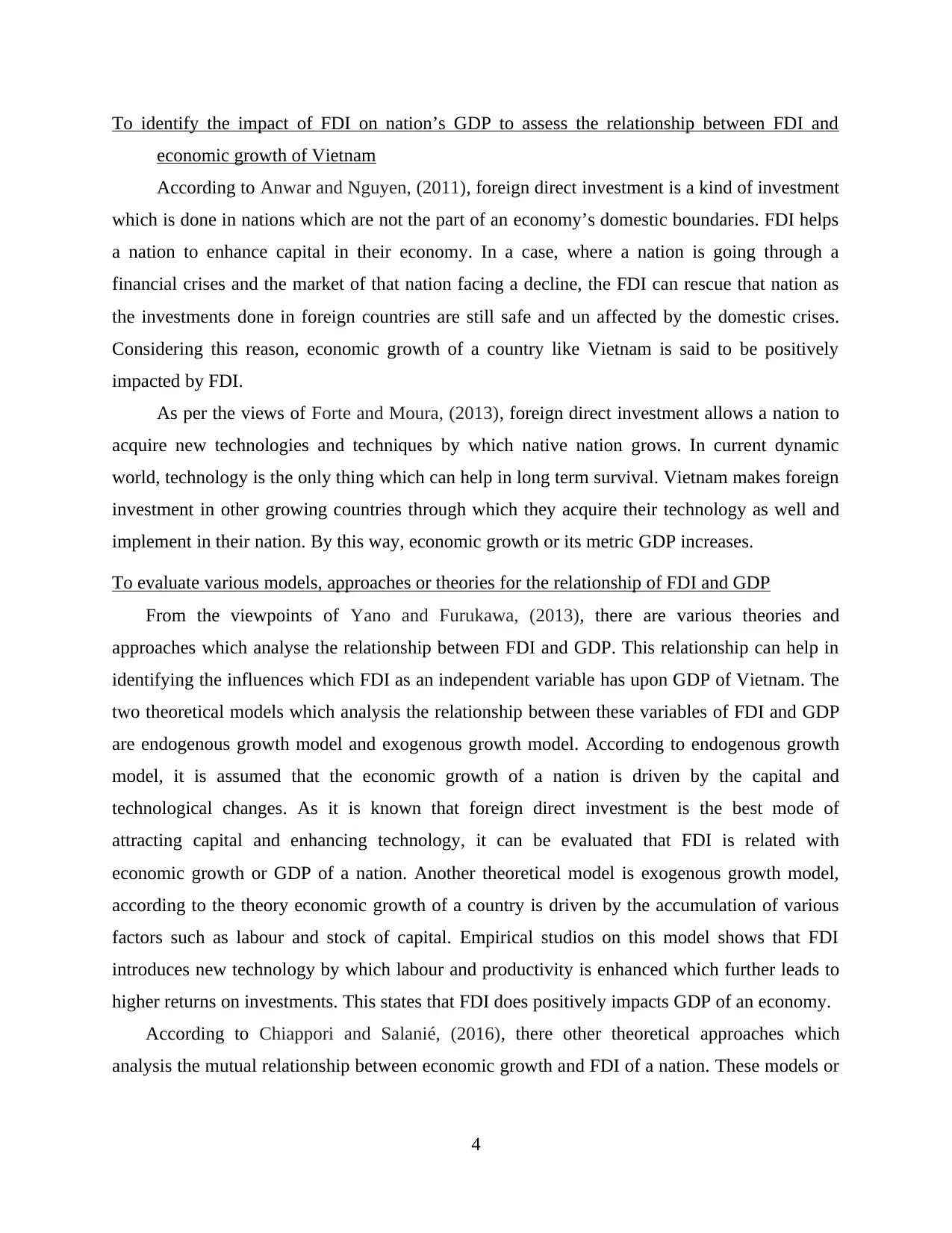
To identify the impact of FDI on nation’s GDP to assess the relationship between FDI and
economic growth of Vietnam
According to Anwar and Nguyen, (2011), foreign direct investment is a kind of investment
which is done in nations which are not the part of an economy’s domestic boundaries. FDI helps
a nation to enhance capital in their economy. In a case, where a nation is going through a
financial crises and the market of that nation facing a decline, the FDI can rescue that nation as
the investments done in foreign countries are still safe and un affected by the domestic crises.
Considering this reason, economic growth of a country like Vietnam is said to be positively
impacted by FDI.
As per the views of Forte and Moura, (2013), foreign direct investment allows a nation to
acquire new technologies and techniques by which native nation grows. In current dynamic
world, technology is the only thing which can help in long term survival. Vietnam makes foreign
investment in other growing countries through which they acquire their technology as well and
implement in their nation. By this way, economic growth or its metric GDP increases.
To evaluate various models, approaches or theories for the relationship of FDI and GDP
From the viewpoints of Yano and Furukawa, (2013), there are various theories and
approaches which analyse the relationship between FDI and GDP. This relationship can help in
identifying the influences which FDI as an independent variable has upon GDP of Vietnam. The
two theoretical models which analysis the relationship between these variables of FDI and GDP
are endogenous growth model and exogenous growth model. According to endogenous growth
model, it is assumed that the economic growth of a nation is driven by the capital and
technological changes. As it is known that foreign direct investment is the best mode of
attracting capital and enhancing technology, it can be evaluated that FDI is related with
economic growth or GDP of a nation. Another theoretical model is exogenous growth model,
according to the theory economic growth of a country is driven by the accumulation of various
factors such as labour and stock of capital. Empirical studios on this model shows that FDI
introduces new technology by which labour and productivity is enhanced which further leads to
higher returns on investments. This states that FDI does positively impacts GDP of an economy.
According to Chiappori and Salanié, (2016), there other theoretical approaches which
analysis the mutual relationship between economic growth and FDI of a nation. These models or
4
economic growth of Vietnam
According to Anwar and Nguyen, (2011), foreign direct investment is a kind of investment
which is done in nations which are not the part of an economy’s domestic boundaries. FDI helps
a nation to enhance capital in their economy. In a case, where a nation is going through a
financial crises and the market of that nation facing a decline, the FDI can rescue that nation as
the investments done in foreign countries are still safe and un affected by the domestic crises.
Considering this reason, economic growth of a country like Vietnam is said to be positively
impacted by FDI.
As per the views of Forte and Moura, (2013), foreign direct investment allows a nation to
acquire new technologies and techniques by which native nation grows. In current dynamic
world, technology is the only thing which can help in long term survival. Vietnam makes foreign
investment in other growing countries through which they acquire their technology as well and
implement in their nation. By this way, economic growth or its metric GDP increases.
To evaluate various models, approaches or theories for the relationship of FDI and GDP
From the viewpoints of Yano and Furukawa, (2013), there are various theories and
approaches which analyse the relationship between FDI and GDP. This relationship can help in
identifying the influences which FDI as an independent variable has upon GDP of Vietnam. The
two theoretical models which analysis the relationship between these variables of FDI and GDP
are endogenous growth model and exogenous growth model. According to endogenous growth
model, it is assumed that the economic growth of a nation is driven by the capital and
technological changes. As it is known that foreign direct investment is the best mode of
attracting capital and enhancing technology, it can be evaluated that FDI is related with
economic growth or GDP of a nation. Another theoretical model is exogenous growth model,
according to the theory economic growth of a country is driven by the accumulation of various
factors such as labour and stock of capital. Empirical studios on this model shows that FDI
introduces new technology by which labour and productivity is enhanced which further leads to
higher returns on investments. This states that FDI does positively impacts GDP of an economy.
According to Chiappori and Salanié, (2016), there other theoretical approaches which
analysis the mutual relationship between economic growth and FDI of a nation. These models or
4
Paraphrase This Document
Need a fresh take? Get an instant paraphrase of this document with our AI Paraphraser
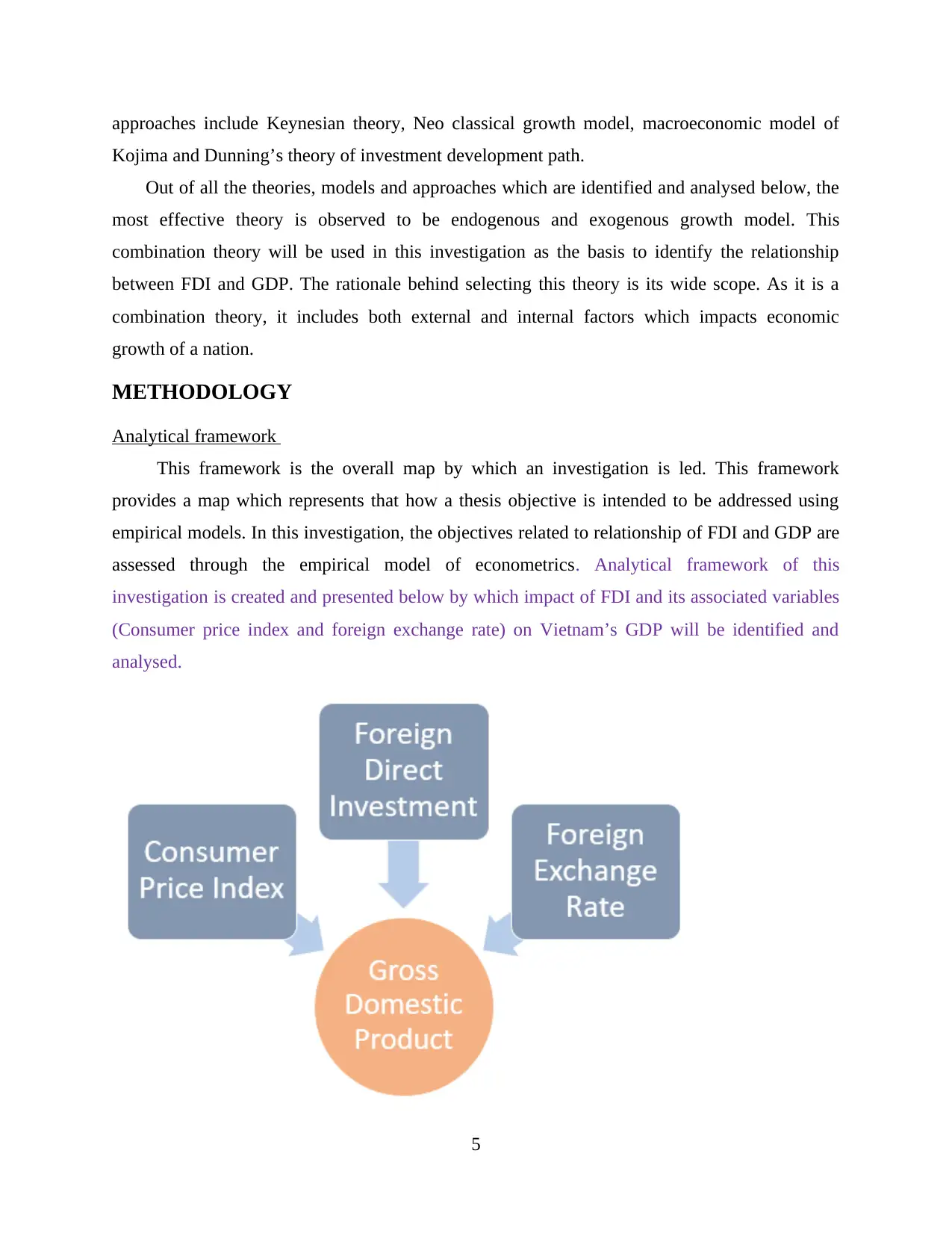
approaches include Keynesian theory, Neo classical growth model, macroeconomic model of
Kojima and Dunning’s theory of investment development path.
Out of all the theories, models and approaches which are identified and analysed below, the
most effective theory is observed to be endogenous and exogenous growth model. This
combination theory will be used in this investigation as the basis to identify the relationship
between FDI and GDP. The rationale behind selecting this theory is its wide scope. As it is a
combination theory, it includes both external and internal factors which impacts economic
growth of a nation.
METHODOLOGY
Analytical framework
This framework is the overall map by which an investigation is led. This framework
provides a map which represents that how a thesis objective is intended to be addressed using
empirical models. In this investigation, the objectives related to relationship of FDI and GDP are
assessed through the empirical model of econometrics. Analytical framework of this
investigation is created and presented below by which impact of FDI and its associated variables
(Consumer price index and foreign exchange rate) on Vietnam’s GDP will be identified and
analysed.
5
Kojima and Dunning’s theory of investment development path.
Out of all the theories, models and approaches which are identified and analysed below, the
most effective theory is observed to be endogenous and exogenous growth model. This
combination theory will be used in this investigation as the basis to identify the relationship
between FDI and GDP. The rationale behind selecting this theory is its wide scope. As it is a
combination theory, it includes both external and internal factors which impacts economic
growth of a nation.
METHODOLOGY
Analytical framework
This framework is the overall map by which an investigation is led. This framework
provides a map which represents that how a thesis objective is intended to be addressed using
empirical models. In this investigation, the objectives related to relationship of FDI and GDP are
assessed through the empirical model of econometrics. Analytical framework of this
investigation is created and presented below by which impact of FDI and its associated variables
(Consumer price index and foreign exchange rate) on Vietnam’s GDP will be identified and
analysed.
5
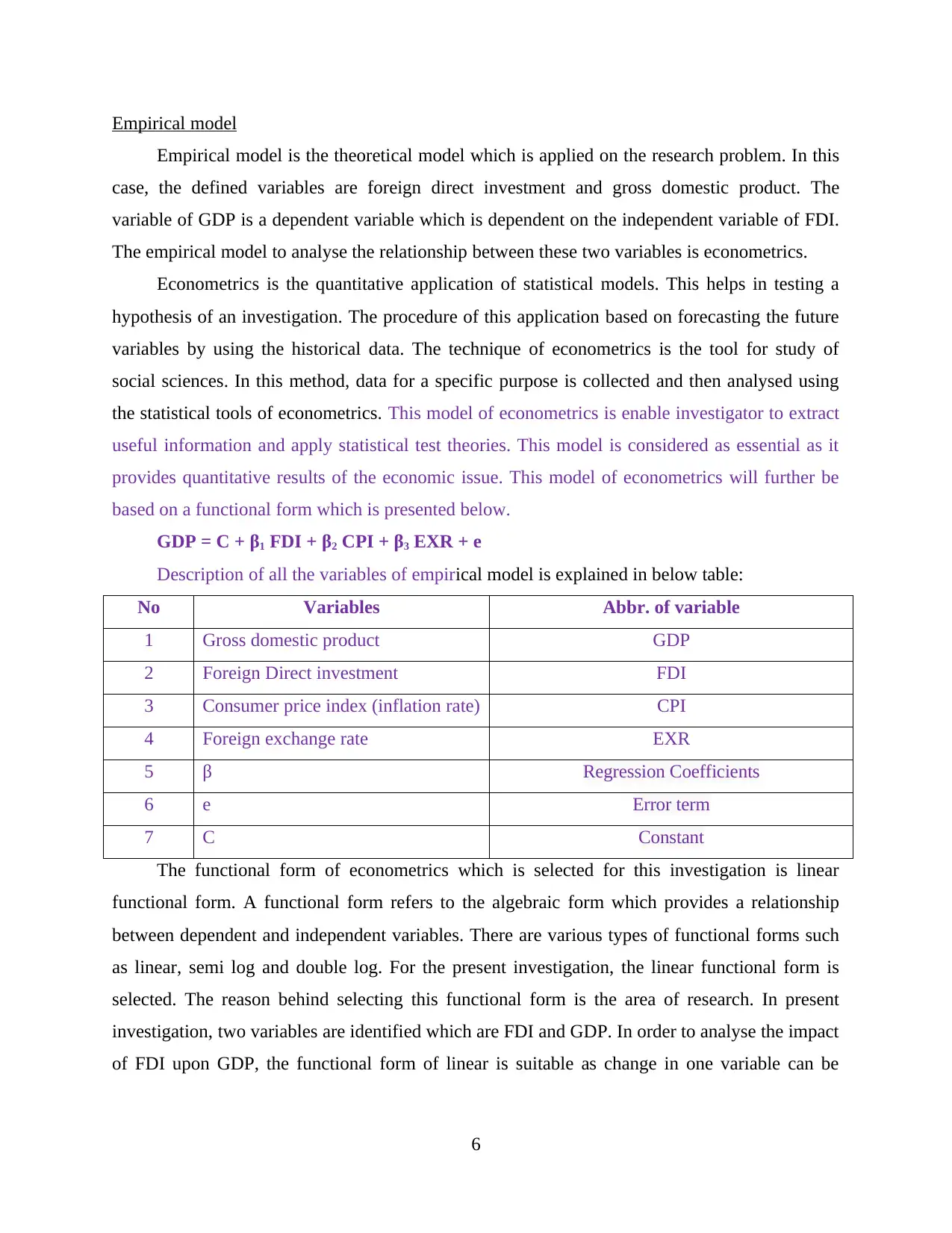
Empirical model
Empirical model is the theoretical model which is applied on the research problem. In this
case, the defined variables are foreign direct investment and gross domestic product. The
variable of GDP is a dependent variable which is dependent on the independent variable of FDI.
The empirical model to analyse the relationship between these two variables is econometrics.
Econometrics is the quantitative application of statistical models. This helps in testing a
hypothesis of an investigation. The procedure of this application based on forecasting the future
variables by using the historical data. The technique of econometrics is the tool for study of
social sciences. In this method, data for a specific purpose is collected and then analysed using
the statistical tools of econometrics. This model of econometrics is enable investigator to extract
useful information and apply statistical test theories. This model is considered as essential as it
provides quantitative results of the economic issue. This model of econometrics will further be
based on a functional form which is presented below.
GDP = C + β1 FDI + β2 CPI + β3 EXR + e
Description of all the variables of empirical model is explained in below table:
No Variables Abbr. of variable
1 Gross domestic product GDP
2 Foreign Direct investment FDI
3 Consumer price index (inflation rate) CPI
4 Foreign exchange rate EXR
5 β Regression Coefficients
6 e Error term
7 C Constant
The functional form of econometrics which is selected for this investigation is linear
functional form. A functional form refers to the algebraic form which provides a relationship
between dependent and independent variables. There are various types of functional forms such
as linear, semi log and double log. For the present investigation, the linear functional form is
selected. The reason behind selecting this functional form is the area of research. In present
investigation, two variables are identified which are FDI and GDP. In order to analyse the impact
of FDI upon GDP, the functional form of linear is suitable as change in one variable can be
6
Empirical model is the theoretical model which is applied on the research problem. In this
case, the defined variables are foreign direct investment and gross domestic product. The
variable of GDP is a dependent variable which is dependent on the independent variable of FDI.
The empirical model to analyse the relationship between these two variables is econometrics.
Econometrics is the quantitative application of statistical models. This helps in testing a
hypothesis of an investigation. The procedure of this application based on forecasting the future
variables by using the historical data. The technique of econometrics is the tool for study of
social sciences. In this method, data for a specific purpose is collected and then analysed using
the statistical tools of econometrics. This model of econometrics is enable investigator to extract
useful information and apply statistical test theories. This model is considered as essential as it
provides quantitative results of the economic issue. This model of econometrics will further be
based on a functional form which is presented below.
GDP = C + β1 FDI + β2 CPI + β3 EXR + e
Description of all the variables of empirical model is explained in below table:
No Variables Abbr. of variable
1 Gross domestic product GDP
2 Foreign Direct investment FDI
3 Consumer price index (inflation rate) CPI
4 Foreign exchange rate EXR
5 β Regression Coefficients
6 e Error term
7 C Constant
The functional form of econometrics which is selected for this investigation is linear
functional form. A functional form refers to the algebraic form which provides a relationship
between dependent and independent variables. There are various types of functional forms such
as linear, semi log and double log. For the present investigation, the linear functional form is
selected. The reason behind selecting this functional form is the area of research. In present
investigation, two variables are identified which are FDI and GDP. In order to analyse the impact
of FDI upon GDP, the functional form of linear is suitable as change in one variable can be
6
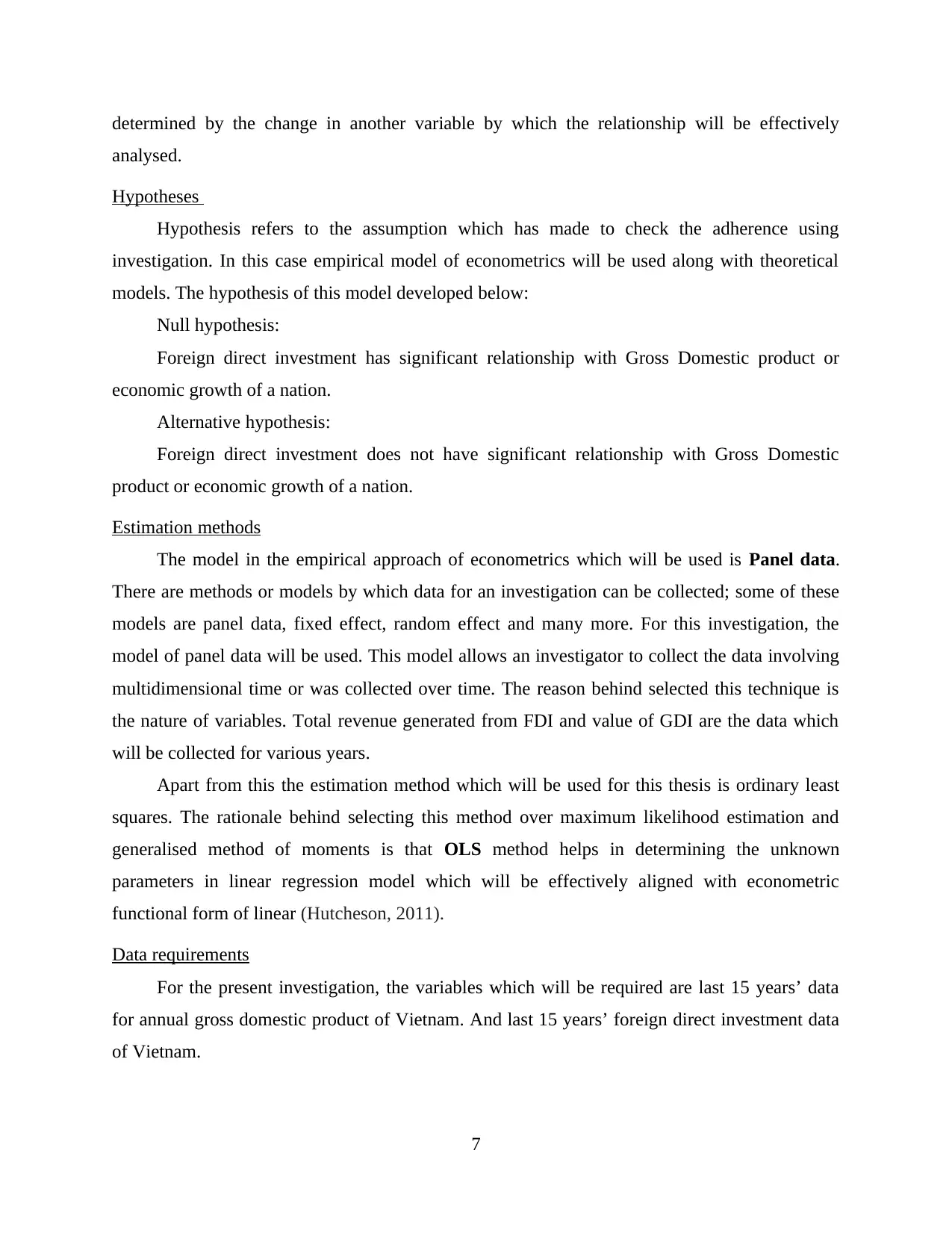
determined by the change in another variable by which the relationship will be effectively
analysed.
Hypotheses
Hypothesis refers to the assumption which has made to check the adherence using
investigation. In this case empirical model of econometrics will be used along with theoretical
models. The hypothesis of this model developed below:
Null hypothesis:
Foreign direct investment has significant relationship with Gross Domestic product or
economic growth of a nation.
Alternative hypothesis:
Foreign direct investment does not have significant relationship with Gross Domestic
product or economic growth of a nation.
Estimation methods
The model in the empirical approach of econometrics which will be used is Panel data.
There are methods or models by which data for an investigation can be collected; some of these
models are panel data, fixed effect, random effect and many more. For this investigation, the
model of panel data will be used. This model allows an investigator to collect the data involving
multidimensional time or was collected over time. The reason behind selected this technique is
the nature of variables. Total revenue generated from FDI and value of GDI are the data which
will be collected for various years.
Apart from this the estimation method which will be used for this thesis is ordinary least
squares. The rationale behind selecting this method over maximum likelihood estimation and
generalised method of moments is that OLS method helps in determining the unknown
parameters in linear regression model which will be effectively aligned with econometric
functional form of linear (Hutcheson, 2011).
Data requirements
For the present investigation, the variables which will be required are last 15 years’ data
for annual gross domestic product of Vietnam. And last 15 years’ foreign direct investment data
of Vietnam.
7
analysed.
Hypotheses
Hypothesis refers to the assumption which has made to check the adherence using
investigation. In this case empirical model of econometrics will be used along with theoretical
models. The hypothesis of this model developed below:
Null hypothesis:
Foreign direct investment has significant relationship with Gross Domestic product or
economic growth of a nation.
Alternative hypothesis:
Foreign direct investment does not have significant relationship with Gross Domestic
product or economic growth of a nation.
Estimation methods
The model in the empirical approach of econometrics which will be used is Panel data.
There are methods or models by which data for an investigation can be collected; some of these
models are panel data, fixed effect, random effect and many more. For this investigation, the
model of panel data will be used. This model allows an investigator to collect the data involving
multidimensional time or was collected over time. The reason behind selected this technique is
the nature of variables. Total revenue generated from FDI and value of GDI are the data which
will be collected for various years.
Apart from this the estimation method which will be used for this thesis is ordinary least
squares. The rationale behind selecting this method over maximum likelihood estimation and
generalised method of moments is that OLS method helps in determining the unknown
parameters in linear regression model which will be effectively aligned with econometric
functional form of linear (Hutcheson, 2011).
Data requirements
For the present investigation, the variables which will be required are last 15 years’ data
for annual gross domestic product of Vietnam. And last 15 years’ foreign direct investment data
of Vietnam.
7
Secure Best Marks with AI Grader
Need help grading? Try our AI Grader for instant feedback on your assignments.
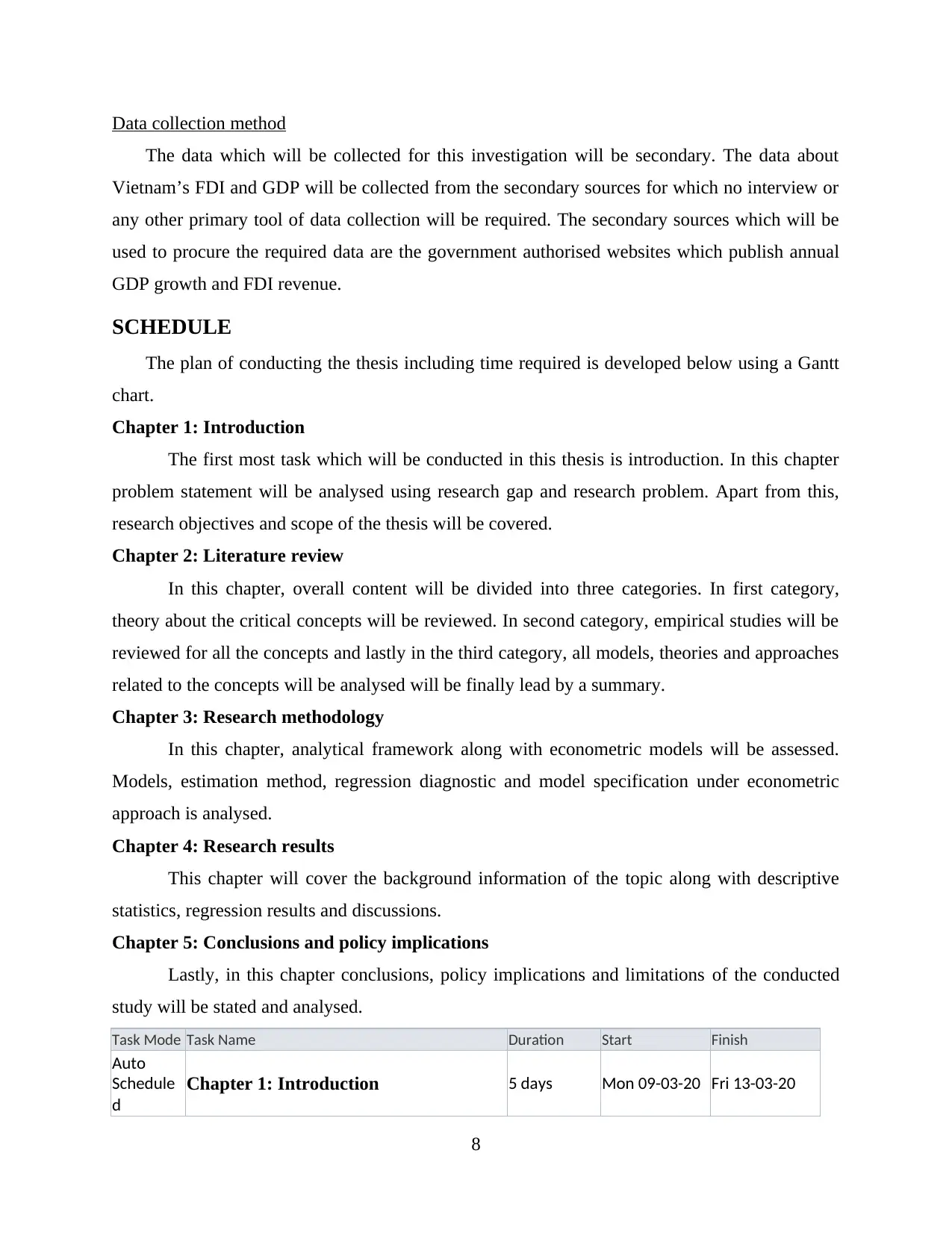
Data collection method
The data which will be collected for this investigation will be secondary. The data about
Vietnam’s FDI and GDP will be collected from the secondary sources for which no interview or
any other primary tool of data collection will be required. The secondary sources which will be
used to procure the required data are the government authorised websites which publish annual
GDP growth and FDI revenue.
SCHEDULE
The plan of conducting the thesis including time required is developed below using a Gantt
chart.
Chapter 1: Introduction
The first most task which will be conducted in this thesis is introduction. In this chapter
problem statement will be analysed using research gap and research problem. Apart from this,
research objectives and scope of the thesis will be covered.
Chapter 2: Literature review
In this chapter, overall content will be divided into three categories. In first category,
theory about the critical concepts will be reviewed. In second category, empirical studies will be
reviewed for all the concepts and lastly in the third category, all models, theories and approaches
related to the concepts will be analysed will be finally lead by a summary.
Chapter 3: Research methodology
In this chapter, analytical framework along with econometric models will be assessed.
Models, estimation method, regression diagnostic and model specification under econometric
approach is analysed.
Chapter 4: Research results
This chapter will cover the background information of the topic along with descriptive
statistics, regression results and discussions.
Chapter 5: Conclusions and policy implications
Lastly, in this chapter conclusions, policy implications and limitations of the conducted
study will be stated and analysed.
Task Mode Task Name Duration Start Finish
Auto
Schedule
d
Chapter 1: Introduction 5 days Mon 09-03-20 Fri 13-03-20
8
The data which will be collected for this investigation will be secondary. The data about
Vietnam’s FDI and GDP will be collected from the secondary sources for which no interview or
any other primary tool of data collection will be required. The secondary sources which will be
used to procure the required data are the government authorised websites which publish annual
GDP growth and FDI revenue.
SCHEDULE
The plan of conducting the thesis including time required is developed below using a Gantt
chart.
Chapter 1: Introduction
The first most task which will be conducted in this thesis is introduction. In this chapter
problem statement will be analysed using research gap and research problem. Apart from this,
research objectives and scope of the thesis will be covered.
Chapter 2: Literature review
In this chapter, overall content will be divided into three categories. In first category,
theory about the critical concepts will be reviewed. In second category, empirical studies will be
reviewed for all the concepts and lastly in the third category, all models, theories and approaches
related to the concepts will be analysed will be finally lead by a summary.
Chapter 3: Research methodology
In this chapter, analytical framework along with econometric models will be assessed.
Models, estimation method, regression diagnostic and model specification under econometric
approach is analysed.
Chapter 4: Research results
This chapter will cover the background information of the topic along with descriptive
statistics, regression results and discussions.
Chapter 5: Conclusions and policy implications
Lastly, in this chapter conclusions, policy implications and limitations of the conducted
study will be stated and analysed.
Task Mode Task Name Duration Start Finish
Auto
Schedule
d
Chapter 1: Introduction 5 days Mon 09-03-20 Fri 13-03-20
8
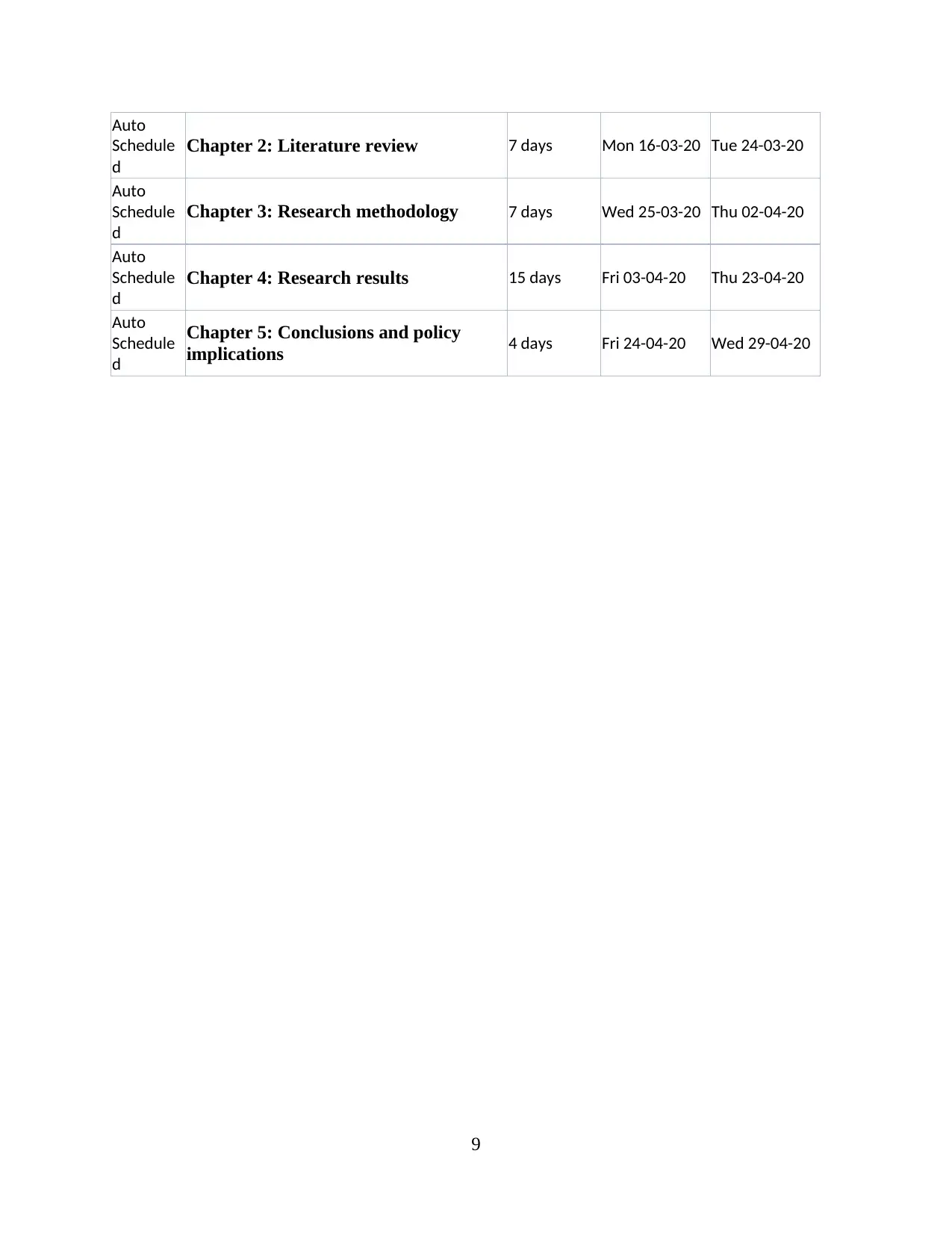
Auto
Schedule
d
Chapter 2: Literature review 7 days Mon 16-03-20 Tue 24-03-20
Auto
Schedule
d
Chapter 3: Research methodology 7 days Wed 25-03-20 Thu 02-04-20
Auto
Schedule
d
Chapter 4: Research results 15 days Fri 03-04-20 Thu 23-04-20
Auto
Schedule
d
Chapter 5: Conclusions and policy
implications 4 days Fri 24-04-20 Wed 29-04-20
9
Schedule
d
Chapter 2: Literature review 7 days Mon 16-03-20 Tue 24-03-20
Auto
Schedule
d
Chapter 3: Research methodology 7 days Wed 25-03-20 Thu 02-04-20
Auto
Schedule
d
Chapter 4: Research results 15 days Fri 03-04-20 Thu 23-04-20
Auto
Schedule
d
Chapter 5: Conclusions and policy
implications 4 days Fri 24-04-20 Wed 29-04-20
9
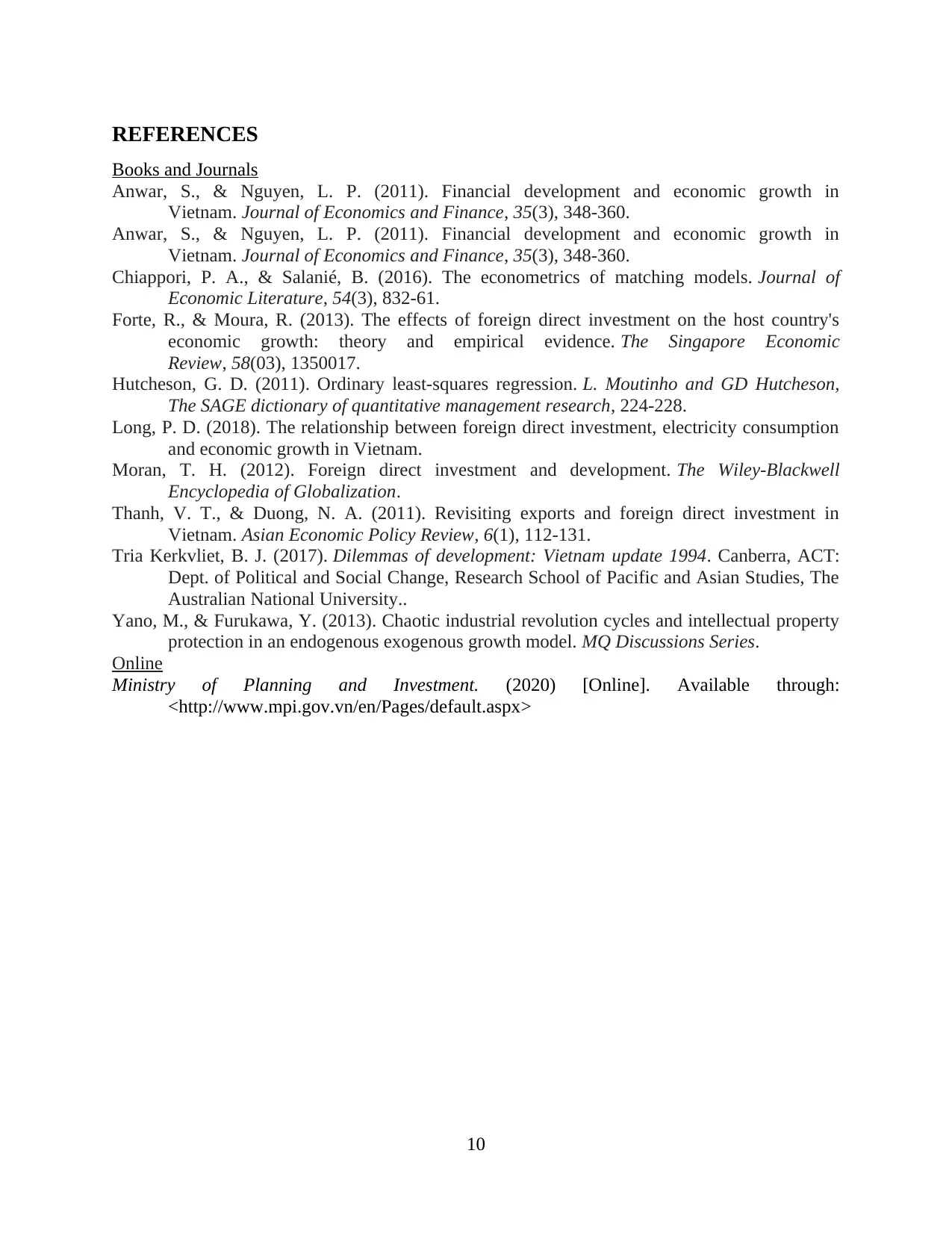
REFERENCES
Books and Journals
Anwar, S., & Nguyen, L. P. (2011). Financial development and economic growth in
Vietnam. Journal of Economics and Finance, 35(3), 348-360.
Anwar, S., & Nguyen, L. P. (2011). Financial development and economic growth in
Vietnam. Journal of Economics and Finance, 35(3), 348-360.
Chiappori, P. A., & Salanié, B. (2016). The econometrics of matching models. Journal of
Economic Literature, 54(3), 832-61.
Forte, R., & Moura, R. (2013). The effects of foreign direct investment on the host country's
economic growth: theory and empirical evidence. The Singapore Economic
Review, 58(03), 1350017.
Hutcheson, G. D. (2011). Ordinary least-squares regression. L. Moutinho and GD Hutcheson,
The SAGE dictionary of quantitative management research, 224-228.
Long, P. D. (2018). The relationship between foreign direct investment, electricity consumption
and economic growth in Vietnam.
Moran, T. H. (2012). Foreign direct investment and development. The Wiley‐Blackwell
Encyclopedia of Globalization.
Thanh, V. T., & Duong, N. A. (2011). Revisiting exports and foreign direct investment in
Vietnam. Asian Economic Policy Review, 6(1), 112-131.
Tria Kerkvliet, B. J. (2017). Dilemmas of development: Vietnam update 1994. Canberra, ACT:
Dept. of Political and Social Change, Research School of Pacific and Asian Studies, The
Australian National University..
Yano, M., & Furukawa, Y. (2013). Chaotic industrial revolution cycles and intellectual property
protection in an endogenous exogenous growth model. MQ Discussions Series.
Online
Ministry of Planning and Investment. (2020) [Online]. Available through:
<http://www.mpi.gov.vn/en/Pages/default.aspx>
10
Books and Journals
Anwar, S., & Nguyen, L. P. (2011). Financial development and economic growth in
Vietnam. Journal of Economics and Finance, 35(3), 348-360.
Anwar, S., & Nguyen, L. P. (2011). Financial development and economic growth in
Vietnam. Journal of Economics and Finance, 35(3), 348-360.
Chiappori, P. A., & Salanié, B. (2016). The econometrics of matching models. Journal of
Economic Literature, 54(3), 832-61.
Forte, R., & Moura, R. (2013). The effects of foreign direct investment on the host country's
economic growth: theory and empirical evidence. The Singapore Economic
Review, 58(03), 1350017.
Hutcheson, G. D. (2011). Ordinary least-squares regression. L. Moutinho and GD Hutcheson,
The SAGE dictionary of quantitative management research, 224-228.
Long, P. D. (2018). The relationship between foreign direct investment, electricity consumption
and economic growth in Vietnam.
Moran, T. H. (2012). Foreign direct investment and development. The Wiley‐Blackwell
Encyclopedia of Globalization.
Thanh, V. T., & Duong, N. A. (2011). Revisiting exports and foreign direct investment in
Vietnam. Asian Economic Policy Review, 6(1), 112-131.
Tria Kerkvliet, B. J. (2017). Dilemmas of development: Vietnam update 1994. Canberra, ACT:
Dept. of Political and Social Change, Research School of Pacific and Asian Studies, The
Australian National University..
Yano, M., & Furukawa, Y. (2013). Chaotic industrial revolution cycles and intellectual property
protection in an endogenous exogenous growth model. MQ Discussions Series.
Online
Ministry of Planning and Investment. (2020) [Online]. Available through:
<http://www.mpi.gov.vn/en/Pages/default.aspx>
10
1 out of 13
Related Documents
Your All-in-One AI-Powered Toolkit for Academic Success.
+13062052269
info@desklib.com
Available 24*7 on WhatsApp / Email
![[object Object]](/_next/static/media/star-bottom.7253800d.svg)
Unlock your academic potential
© 2024 | Zucol Services PVT LTD | All rights reserved.





